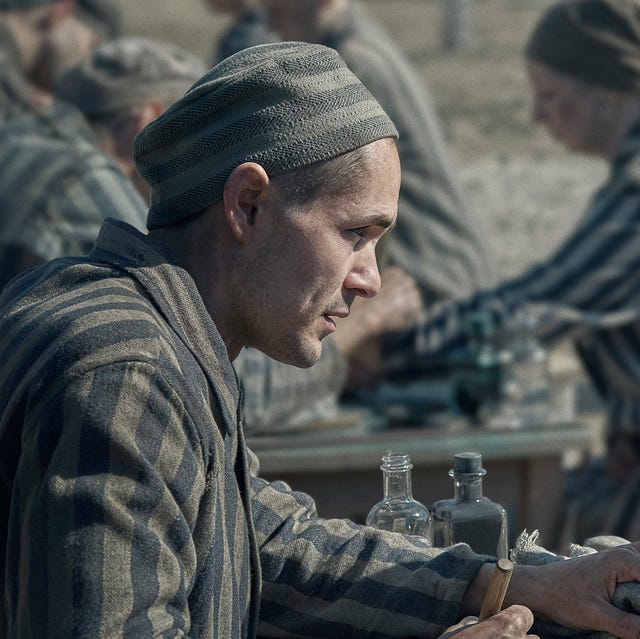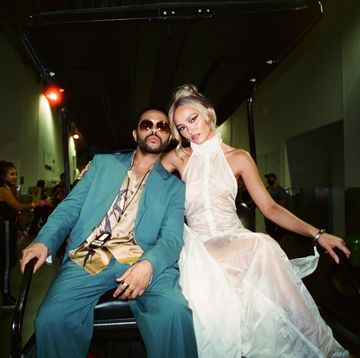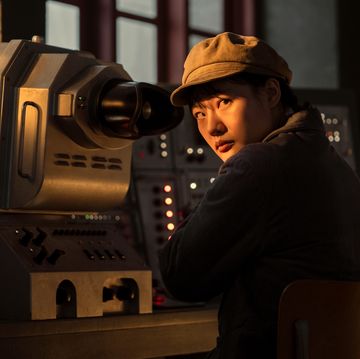The long-waited TV adaptation of the best-selling 2018 book, The Tattooist Of Auschwitz has finally hit TV screens. The six-part series, featuring Harvey Keitel, Melanie Lynskey, Jonah Hauer-King, and Anna Próchniak, tells a love story between two people during the Holocaust, set in the Auschwitz-Birkenau death camp during World War II.
The book, written by the New Zealand author Heather Morris, has sold more than three million copies around the world since its release, and in 2018 it became number one on the New York Times Bestseller lists. Morris has said previously that she was introduced to an 87-year old man called Ludwig Sokolov (born Eisenberg) – known as Lali, or Lale as she initially wrote in the book – in Australia in 2003, shortly after his wife, Gita, had died. He told her the story of their romance and survival in Auschwitz. It initially started out as a screenplay, but when Morris failed to get it optioned, she wrote the book instead, telling The Guardian in 2018: “95 percent of it is as it happened, researched and confirmed.” But how much of the series, directed by Tali Shalom-Ezer, is actually true?
The story in the book
The book opens with Lali being sent to Auschwitz, where, under the tutelage of fellow Jewish prisoner, Pepan, he is taught how to tattoo, as Pepan is the person forced to brand unique numbers onto the prisoners' bodies. The Slovakian Lali falls in love with a woman, Gita – also from Slovakia – while he is tattooing the number on her arm, and the pair begin a secret relationships in the camp, but Gita won’t tell him her surname, as she is sure they will never make it out of Auschwitz alive. Gita works at a camp warehouse that confiscates items belonging to prisoners on arrival and she sneaks some valuable jewels and money out to Lali, who then swaps them with a German worker for medicine, or to bribe the SS guards. When Gita falls ill with typhoid, Lali is able to get penicillin for her.
With news that the Russians are advancing, the prisoners are moved. Before Gita leaves, she tells Lali that her surname is Furman. Lali is sent to Mauthausen and then another Austrian death camp, but manages to escape. However, he is then forced to work for Russian soldiers. But he manages to slip away again, and heads to Bratislava, where he is told many Slovakian prisoners are being sent, and after waiting two weeks at the train station, he finally catches sight of Gita. He asks her to marry him, and she happily accepts.
The real life events
Much of the book is as how it happened in real life. As per Morris in the The Guardian, Lali really was a tattooist as a prisoner in Auschwitz: It was “a way to survive”, says Morris. “As long as he kept doing it, he might wake up the next morning.” So in July 1942, Lali, who was prison number 32407, met a young woman called Gisela "Gita" Fuhrmannova, tattooed the numbers on her, and the pair did really fall in love.
Criticism for the book came from Wanda Witek-Malicka of the Auschwitz Memorial Research Center, who said that Morris’ claim that Gita’s identification number tattooed on her arm was 34902 was wrong – “we do not find any surviving documents with her personal data or relating to number 34902 issued in the women’s series” – and that a prisoner arriving at Auschwitz at the time Gita could not have received such a high number. Witek-Malicka added that according to Gita's own testimony, her identification number was 4562. The number was then changed in future copies of Morris’ book.
Within the camp, as their romance was forbidden, Lali and Gita smuggled letters between their dormitories and fell into a relationship. Lali also managed to smuggle contraband items to help get medicine and other favours for the prisoners. Eight days before Auschwitz was liberated, in the Mauthausen camp, some Czech prisoners swapped the Jewish star on his uniform for a red triangle, which meant he would be safer as a political prisoner. He later managed to escape and returned to Bratislava, to find Gita.
There were other historical inconsistencies, critics said, between the book and reality, such as the availability of antibiotics during the war, but as Morris told Sky: “This is a work of fiction based on the memory of one man. It is not the story of the Holocaust. My novel is not an academic, historical account. So many survivors have thanked me for telling Lali and Gita’s story – they see it, in many ways, as their story too.”
What happened to Lali and Gita after the war?
The pair married in 1945 – changing their surname to the more Russian-sounding Sokolov – and then migrated to Melbourne in 1948, where they set up a textile business. In 1961, they had a son, Gary. But they refused to ever talk in public about how they’d met. Until Lali told his story to Heather in 2003, Gary had never even known of his mum’s full past. Morris told The Guardian: “She never spoke about her time in Auschwitz. Not even to her son Gary.”
Lali died in 2006, before he could see the publication of his and Gita’s story in the book. But his son, Gary, told Sky about what he hopes people will take from the series: “I hope they will believe that bad times do end. You have got to stay positive as much as you possibly can. I hope that whatever people are going through, the show will give them a sense that there is a future… That’s an amazing legacy to leave people – there is always hope.”
The Tattooist Of Auschwitz is now available on Sky Atlantic and NOW TV














